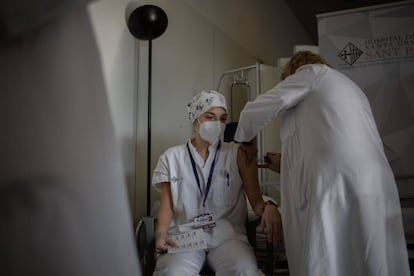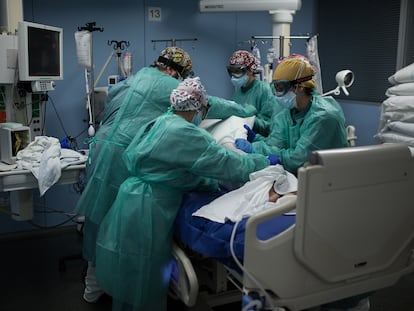Spain’s regions are now administering as many Covid vaccines in a day as they did the first week
Most territories have now reduced the number of doses that they are keeping back for the second round of shots, which will start being administered from January 18

The third week of the Covid-19 vaccination campaign in Spain has seen a significant improvement in the rate of doses administered – despite the chaos caused this weekend by the arrival of Storm Filomena in areas such as Madrid.
According to the latest data from the central Health Ministry, the number of people given the vaccine on Wednesday, 94,548, was practically the same as those administered in the entire first week of the campaign (99,753), which officially began on December 27 and was considerably disrupted due to the New Year holidays.
One of the factors that is speeding up the process is the fact that most regions have reduced the number of doses that they are keeping back for unforeseen circumstances
That said, in order to reach the government’s objective of 30 million people vaccinated by the summer, the rhythm still needs to increase. If the only vaccines used are those that require two doses, and vaccinations are administered during the weekend, to get to 30 million people by July 1, Spain will need to vaccinate a total of 1.3 million people a week, administering a total of 2.6 million doses. Given that the current rate is around 700,000 a week, the pace will need to be picked up by a multiple of four in order to reach the objective. Currently, Spain is using the Pfizer-BioNTech vaccine, which requires two doses. The next to arrive will be the Oxford/AstraZeneca inoculation, which also consists of two injections. The Janssen vaccine is a single dose.
Spokespersons from the regional healthcare systems, which are in charge not just of handling the pandemic in their territories but also the vaccination process, say that the improvement in the vaccination rates is due to better organization, as well as the fact that the medical professionals administering the vaccines having gained confidence with a process that is slightly more complicated than the ones they are used to.
What’s more, practically all of the regions have now begun to vaccinate healthcare workers, meaning that the vaccination teams do not have to travel to other areas in order to administer the doses, and the environment in which they are being given is better prepared for the cold storage of the vaccine.
The priority is to increase the population that has been vaccinated in order to meet the deadlines and keep up the rhythmFlorentino Pérez Raya, president of the General Nursing Council
Of particular note are the regions where the process began more slowly. While Madrid is still the second slowest, on Wednesday it administered 14,000 doses. This ranks it fourth in absolute terms, and it has so far administered 42% of the vaccines it has received. The most active territories are the North African city of Melilla, which has injected 91% of received shots, followed by Valencia with 85% and Asturias with 79%.
Another of the factors that is speeding up the process is the fact that most regions have reduced the number of doses that they are keeping back for unforeseen circumstances. In the first week of the campaign, and due to fears that the supply would be interrupted, practically all of the country’s regions – apart from Asturias, and the North African cities of Ceuta and Melilla – administered fewer doses because they were keeping back the second injection for the same recipients. That dose is administered 21 days after the first. If that was the reason for these regions not having used all of the vaccines they have received, the percentage of use should be 50%. In the areas that opted for this strategy, Catalonia reports having used 57% and La Rioja 60%, but in Madrid and the Basque Country, the percentages are 42% and 41%, respectively, suggesting that other factors are causing the delays.
The president of the General Nursing Council, Florentino Pérez Raya, believes that “the priority is to increase the population that has been vaccinated in order to meet the deadlines and keep up the rhythm.” He adds that it is of key importance to “administer 100% of the received vaccinations, and we are calling on those regions who have low percentages of administered vaccines to speed up and to get up to date as soon as possible, as this should be a national priority.” However, he also warns that vaccination experts have expressed their concerns over delays to future supplies, “and that the second doses might not arrive for some people who have already been vaccinated. In which case, it could be reasonable to keep back a small proportion.” He adds that this decision should have a “state-wide vision,” with a guarantee from the Health Ministry that the second doses will arrive 21 days after the first.
Meanwhile, the experts are divided on the impact that the administration of the second dose will have on the speed of the process. Those who were vaccinated on the first full day of the campaign, on December 28, are due to start receiving the shots from January 18. The number of people receiving inoculations is likely to grow from this date, but it is possible that there will be fewer new recipients, given that part of the efforts will be dedicated to administering the second shots to those who have already had the first.
English version by Simon Hunter.
Tu suscripción se está usando en otro dispositivo
¿Quieres añadir otro usuario a tu suscripción?
Si continúas leyendo en este dispositivo, no se podrá leer en el otro.
FlechaTu suscripción se está usando en otro dispositivo y solo puedes acceder a EL PAÍS desde un dispositivo a la vez.
Si quieres compartir tu cuenta, cambia tu suscripción a la modalidad Premium, así podrás añadir otro usuario. Cada uno accederá con su propia cuenta de email, lo que os permitirá personalizar vuestra experiencia en EL PAÍS.
¿Tienes una suscripción de empresa? Accede aquí para contratar más cuentas.
En el caso de no saber quién está usando tu cuenta, te recomendamos cambiar tu contraseña aquí.
Si decides continuar compartiendo tu cuenta, este mensaje se mostrará en tu dispositivo y en el de la otra persona que está usando tu cuenta de forma indefinida, afectando a tu experiencia de lectura. Puedes consultar aquí los términos y condiciones de la suscripción digital.
More information
Últimas noticias
Most viewed
- Oona Chaplin: ‘I told James Cameron that I was living in a treehouse and starting a permaculture project with a friend’
- Reinhard Genzel, Nobel laureate in physics: ‘One-minute videos will never give you the truth’
- Sinaloa Cartel war is taking its toll on Los Chapitos
- Why the price of coffee has skyrocketed: from Brazilian plantations to specialty coffee houses
- Silver prices are going crazy: This is what’s fueling the rally










































